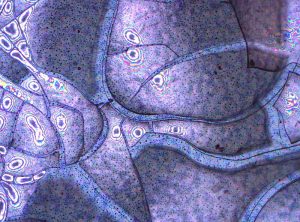Commercial products, such as cosmetics and paints (4), contain titanium oxide (TiO2) nanoparticles; antimicrobial agents, fabrics, and food preservatives (5) contain silver (Ag) nanoparticles. Nanoparticles, synthetically made molecules that range in size from 1 nm to 100 nm (5), are found in every day household items.

Titanium Oxide Nanoparticle on Stainless Steel (Image Courtesy of Wikimedia Common; Author: Iuliia Karlagina; Source: Picture Uploaded by Original Photographer)
A recent publication in the Journal of Environmental Toxicology and Pharmacology by researchers at National Tsing Hua University in Taiwan revealed the potential risks that nanoparticles of TiO2 and Ag as well as Ag+ ions pose to the blood-brain barrier of animal cells (2). Chen and fellow colleagues (2) simulated the conditions of the blood-brain barrier in vitro. As illustrated in the figure below, the blood brain barrier is a highly selective membrane that only allows specific molecules, such as glucose and insulin, and ions to pass between the blood and the brain (1).

Blood-Brain Barrier (Image Courtesy of Wikimedia Commons; Authors: Helen Stolp, Shane Liddelow, Ines Sa-Pereira, Katarzyna Dziegielewska, Norman Saunders; Source: Journal Article)
The study (2) concluded that silver nanoparticles not only affect the selectivity of the blood-brain barrier, but it can lead to a higher likelihood of genetic mutations and even cell death. Due to the small size of silver nanoparticles (8.4 nm) and TiO2 nanoparticles (6 nm) (2), they were able to bypass the selective membrane and enter into the central nervous system. Furthermore, the silver ions and titanium oxide nanoparticles can alter the permeability of the blood-brain barrier by cell-to-cell interactions, known as cytokine secretions (2). This effect is further intensified in the presence of lipopolysaccharide, which is a type of molecular marker found on the surface of gram-negative bacteria (6). Their findings suggest that when we are pre-exposed to TiO2 and/or Ag nanoparticles while fighting a bacterial infection, our bodies will elicit an immune response that can be detrimental to our brain-blood barrier (2).
This study provides a stepping stone for future studies to be performed in determining the potential health risks associated with other types of inorganic or synthetic nanoparticles, commonly found in commercial products. Personally, for the safety and well-being of people, re-establishment of national and global guidelines on the commercial use of nanoparticles is necessary.
–Gloria Kwong
References
- Abbott, N. J., Patabendige, A. A. K., Dolman, D. E. M., Yusof, S. R., & Begley, D. J. (2010). Structure and function of the blood–brain barrier. Neurobiology of Disease, 37(1), 13-25.
- Chen, I.-C.; Hsiao, I.-L.; Lin, H.-C.; Wu, C.-H.; Chuang, C.-Y.; Huang, Y.-J. Environmental Toxicology and Pharmacology 2016, 47, 108–118.
- Clett Erridge, Elliott Bennett-Guerrero, Ian R. Poxton, Structure and function of lipopolysaccharides, Microbes and Infection, Volume 4, Issue 8, July 2002, Pages 837-851, ISSN 1286-4579.
- Gupta, S.; Tripathi, M. Open Chemistry 2012, 10 (2).
- Rai, M.; Yadav, A.; Gade, A. Biotechnology Advances 2009, 27 (1), 76–83.
- Stow, J. L.; Low, P. C.; Offenhäuser, C.; Sangermani, D. Immunobiology 2009, 214 (7), 601–612.

One response to “The Truth Behind Silver and Titanium Oxide Nanoparticles”